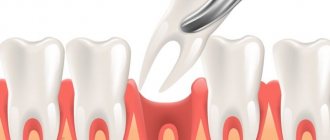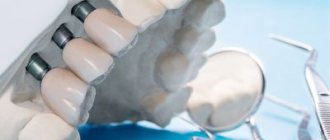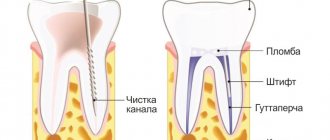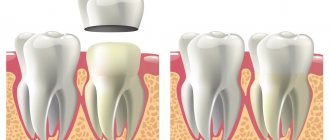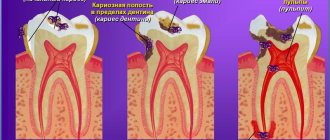- About the service
- Prices
- Consultation
- Stock
- Advantages
- Reviews
- Doctors
- Portfolio
- Licenses
- Contacts
Depulping a tooth before prosthetics in Moscow is a mandatory procedure that must be carried out in case of infection. It allows you to solve the problem without allowing further spread of the pathology. In our dental clinic, the pulp and nerve removal procedure is carried out by qualified doctors using modern technologies. At the same time, the cost is affordable, the quality of services is high. You can find out the exact price and make an appointment by phone or through the website.
Advantages of treatment at the DentBerg dental clinic in Moscow:
- the patient will not experience any discomfort during depulpation;
- the process of dental canal treatment occurs using modern equipment;
- in our dentistry we are ready to take on difficult cases;
- if necessary, after depulpation we can install a metal-ceramic crown;
- processing occurs using modern medical preparations;
- minimal risk of complications in the future;
- our dentists will remove a bundle of nerves only if indicated;
- guarantee for the services provided.
Tooth depulpation is carried out only when it is necessary to remove nervous tissue objectively. At the same time, our doctors act as carefully as possible to preserve most of the crown. They also carefully check the condition of the root canals after treatment. This allows you to avoid unpleasant situations associated with tool tips getting stuck in a tooth.
Prices
| Consultation | |
| Initial dental consultation and treatment plan | 500 rub. |
| Orthopedics | |
| Complete removable denture with ivocril teeth | 30,000 rub. |
| Partial removable denture (up to 3 teeth) with ivocril teeth | 25,000 rub. |
| Unilateral replacement of defects (up to 2 teeth) | 25,000 rub. |
| Metal-free splinting clasp according to the QUATTROTI system | 44,000 rub. |
| Simple clasp (Germany) | 39,000 rub. |
| Complex clasp on BREDENT attachments | 60,000 rub. |
| Complex one-sided clasp with a locking lock MK-1 (the price includes the cost of the lock MK-1) | 75,000 rub. |
| Attachment "Bredent" | 6,500 rub. |
| Clasp prosthesis Dental Di (nylon) | 50,000 rub. |
| Stump inlay, pin | 8,000 rub. |
| EMAKH ceramic inlay, veneer, crown (with coloring) | 25,000 rub. |
| Uni root tab | 10,000 rub. |
| Ceramic inlay, veneer, crown (with application of ceramic mass) | 30,000 rub. |
| Relining a removable denture | 4,000 rub. |
| Prosthesis fracture | 4,000 rub. |
| Welding of one tooth, clasp (Russia, Germany) | 4,000 rub. |
| Replacing the matrix | 3,000 rub. |
| Cleaning the prosthesis | 2,000 rub. |
| Prosthesis correction with soft plastic | 5,000 rub. |
| Casts "Elite" | 1,000 rub. |
| Fixation 1 unit crowns, permanent inlays with double-curing cement “U200” | 1,500 rub. |
| Dental mouthguard (silicone) | 5,000 rub. |
| Crown, metal-ceramic tooth “Estet-Lux” (Japan) | 16,500 rub. |
| Ceramics based on In Ceram – Zirconia (zirconium dioxide) | 30,000 rub. |
| Crown, plastic tooth | 5,000 rub. |
| Diagnostic model WAX-AP (1 unit) | 1,500 rub. |
| Removable denture supported by implants with a locator fixation system | 50,000 rub. |
| Locator 1 unit | 14,000 rub. |
| Metal-ceramic crown on an implant (cement fixation) | 25,000 rub. |
| Custom abutment | 10,000 rub. |
| Custom abutment (zirconia) | 26,000 rub. |
| Zirconium crown on an implant | 35,000 rub. |
| Removable denture supported by implants, beam system | 180,000 rub. |
| Temporary crown on an implant (Laboratory) | 8,000 rub. |
| Metal-ceramic crown on a transocclusal fixation implant (REMANIUM) | 25,000 rub. |
| Acrylic removable denture (Germany) | 28,000 rub. |
| Acrylic microprosthesis (immediate) | 15,000 rub. |
| Individual spoon | RUB 2,450 |
| Prosthesis reinforcement (mesh) | 4,000 rub. |
| Individual reinforcement of the prosthesis | 8,000 rub. |
| Removable reinforced prosthesis with telescopic fixation | 60,000 rub. |
| Diagnostics | |
| X-ray (sight) image of teeth | 400 rub. |
| Panoramic photograph of teeth (orthopantomogram) | 1,000 rub. |
Stump inlay and crown or filling for a pulpless tooth?
Developments in modern dentistry do not stand still. Based on various types of research, dentists are finding new and more advanced methods for restoring teeth. If your dentist 10 years ago was in favor of restoring the coronal part of a pulpless tooth using fiberglass pins and modern filling material, and today he claims that the only reliable way is a stump inlay and a metal-ceramic crown on the tooth, do not rush to accuse him of incompetence or desire for profit. Observations in practice show that pulpless teeth restored with an inlay and a crown last much longer.
Why does such a tooth need to be crowned?
When the pulp in a tooth is removed, the tooth ceases to receive the natural nutrition that it received when the nerve endings were preserved. The tooth becomes fragile, more susceptible to injury even from minor loads. The most unpleasant situation that can happen to such a “weakened” tooth is a chip of the tooth wall under the gum. When the wall of a tooth chips, capturing the part of the tooth located under the gum, its restoration becomes impossible, the dentists have only one verdict - removal. Which subsequently entails implantation and the cost of restoring a lost tooth becomes more expensive before our eyes.
Therefore, it is worth taking care in advance to ensure that your tooth remains in place intact and unharmed for many years, despite the fact that it has already been subjected to such serious treatment as nerve removal. Despite all the wonderful aspects of implantation, your own tooth is always better than an artificial one.
With deep caries, there is still a chance to leave the tooth “alive”. But even with such a diagnosis, the doctor will not give you a 100% guarantee that the nerve will remain in place. Despite the latest X-ray methods, in case of deep caries, the treatment plan is often determined after the fact, when the doctor has removed all the affected tooth tissue and it is already clear how far the pulp is from the filling. Sometimes it happens that it is possible to preserve the nerve, but after treatment for several weeks the patient may complain of pain when biting on this tooth, or a reaction to hot or cold. An experienced dentist will carefully listen to the patient’s complaints, how critical the pain is and, if they are tolerable, will give recommendations to wait a while. And it often happens that the pain subsides and does not return. But it also happens that you have to open the filling and treat the root canals.
What to do if the nerve needs to be removed?
When a problem is discovered that the inflammatory process has already progressed much further than even deep caries, ideally you need to go to an endodontist for dental treatment under a microscope. Because it is possible to clean and seal the canal efficiently only with the help of this modern equipment. An experienced endotontist uses a microscope to achieve a perfectly sterile effect in the canals. Subsequently, a correctly installed core inlay and crown do not give the slightest chance for microorganisms to penetrate into the root canals. When restoring the coronal part simply with filling material, such an effect is almost impossible to achieve.
A huge advantage of the stump inlay from pins is that it is securely fixed in the root canal to the optimal depth and provides an even distribution of the load on absolutely all areas of the tooth, preventing overload at any individual points.
Types of stump inlays.
The inlay can be of different types: collapsible and solid, which one should be installed directly in your case, your doctor will recommend to you.
Also, stump inlays differ in the material from which they are made:
- Metal.
- All-ceramic.
- An inlay made of a special alloy containing precious metals (widely used for people with allergies).
- Inlay made of zirconium dioxide alloy.
If a patient categorically refuses to restore a pulpless tooth by installing an inlay and a crown, our specialists, at the patient’s request, can restore such a tooth with a filling composite, but, alas, we do not provide a guarantee for such irrational treatment. Because it is very important for us to do our work for you efficiently, preserving your teeth for many years. And we are responsible for our treatment.
Some may view this approach as an attempt to make treatment more expensive than it could be, but no. Rather, the doctor who offers you to restore a pulpless tooth “without problems” using the most modern filling materials is seeking profit. Because such treatment will soon lead you to treatment again with the same tooth.
In our clinic you will receive high-quality treatment at all stages of dental prosthetics:
- The endodontist achieves ideal cleanliness and high-quality filling of the canals using treatment techniques under a microscope.
- The orthopedic dentist prepares the tooth cavity and takes impressions for the core inlay and subsequently for the permanent crown. The impressions are sent to the laboratory of our highly qualified technicians, with whom we have been collaborating for many years. And the requirements for them are as high as for our specialist doctors. The process of making a permanent crown takes place in several stages. The result is a perfect match of shape and color with your teeth. Until the permanent crown is made, the patient walks with a temporary crown and does not experience any discomfort when chewing, talking, or smiling.
- Our orthopedic dentists always use special dental binoculars, which are essentially an approximate analogue of a microscope, in order to achieve an ideal fit between the stump and crown.
Many patients are frightened only by the words and definitions themselves: “crown”, “prosthetics”. But it is precisely this approach that keeps a pulpless tooth functional and healthy much longer than one simply covered with a filling.
Promotions of the DentBerg clinic
Ceramic veneer
Promotion for installation of E-Max ceramic veneer at the DentBerg clinic.
25,000 19,900 rub. More details
the promotion is valid until 12/31/2021
5% discount on dental prosthetics for pensioners
Get a 5% discount on dental prosthetics at the DentBerg clinic.
More details
the promotion is valid until 12/31/2021
Indications for tooth depulpation
A direct indication for tooth depulpation before prosthetics is the situation of pulp infection. In this case, the tissue must be removed to avoid further spread of inflammation, which can involve the root and deeper tissues.
Essentially, the indications for depulpation come down to the following:
- sharp and severe pain, which is replaced by aching pain;
- pulpitis;
- periodontitis;
- caries with pulp infection;
- exposure of the pulp as a result of mechanical damage to the tooth.
Why is it necessary to remove a nerve?
Removal of the dental nerve is required in advanced inflammatory processes that affect both soft and hard tissue structures, including the pulp.
The most common reasons:
- periodontitis,
- pulpitis,
- benign neoplasm near the root,
- deep pulpal caries.
Depending on the type of pathological process and the size of the affected area, removal is carried out with partial preservation of the pulp or complete preservation from all canals. Amputation of part of the nerve is usually used for dental caries. In other cases, complete removal is usually necessary.
What you need to know about pulp removal before prosthetics
The standard procedure for depulping a tooth includes removing the enamel and then the pulp, cleaning the canals, using medication and filling or prosthetics. In the past, dentists were more likely to use a permanent filling or crown. Nowadays, more and more doctors use a temporary filling first to monitor the progress of treatment. And only after they are convinced that the infection process has stopped, they proceed directly to prosthetics.
It should be noted that the choice of a specific course of action directly depends on what will be more logical in a particular case. That is, the doctor makes a decision based on the overall picture and test results. In any case, before depulping, a photograph is taken.
Contraindications
Doctors at the SDent aesthetic dentistry center collect all data about the patient’s condition before starting treatment. In the health questionnaire, the patient notes the characteristics of his body, and the doctor conducts a survey. Planned nerve removal is not performed if:
- high blood pressure, hypertensive crisis;
- first, third trimester of pregnancy (provided there is no acute pain);
- acute inflammatory diseases of the mucous membranes and facial skin;
- acute respiratory and viral diseases, etc.
Reviews from our patients
patient
Ivanova. A.A.
I was always afraid of the drill... But, like many, I was forced to meet with it in the dentist’s office. In fact, everything went much easier compared to what I expected. And there was no pain, thank you.
Read full review
patient
Kotikova D.B.
patient
Demidov V.G.
They removed the pulp and made a prosthesis in about a few hours. Fast, professional, and also inexpensive. What else is needed?
Read full review
patient
Filatova V.V.
patient
Nekrasova I.A.
I applied on the advice of a friend and did not regret it. They work well, with high quality. I don't need anything else. They still provide guarantees.
Read full review
patient
Nasyrova R.R.
patient
Popov. S.V.
At the Dentberg clinic I was pleased with the attention to patients. Answered any questions. Everything was done efficiently, more than a year passed, the inflammation did not return.
Read full review
All reviews
Complications
The most common complications after nerve removal before replacement are pain and swelling. Normally, these symptoms go away within a day at most. If the pain does not go away, intensifies, or swelling does not subside, you need to consult a doctor. He will conduct diagnostics to identify the causes. It could be:
- Poor quality channel cleaning
. An incorrectly chosen length of the tool does not allow you to go through the canal to the end. Remains of pulp cause inflammation - residual pulpitis. - Root canal perforation
. Through the destroyed apex, the infection penetrates into the periodontium (tissue around the tooth), causing pain. - Missing tooth canals
. All canals are not always visible on the image, and this is the only source of information for the dentist. The remaining pulp becomes inflamed, causing discomfort. - Tooth fracture
. If the anatomical shape of a tooth is not restored immediately, it may break. - Violation of sealing technology
. This may be incorrect proportions for mixing the composition or the filling material getting on soft tissues.
Sometimes, after endodontic treatment, the tooth darkens. Without pulp, no food is supplied to the tooth, and cells are not renewed. Dentin dries out and its color darkens. Another reason is that the enamel becomes porous and pigments penetrate through it more easily. Sometimes, the tooth darkens due to hemorrhage when the nerve is removed before prosthetics.
Don't be afraid, it's not dangerous. The denture will provide a protective barrier and hide discoloration.

